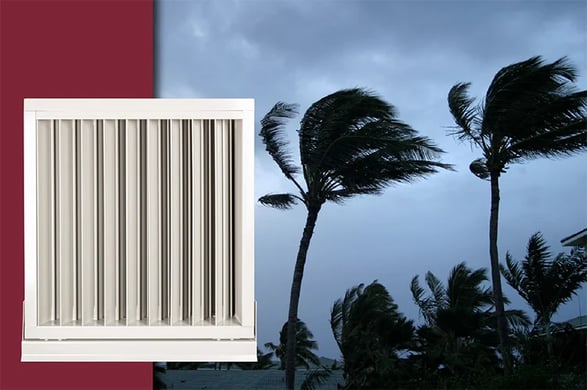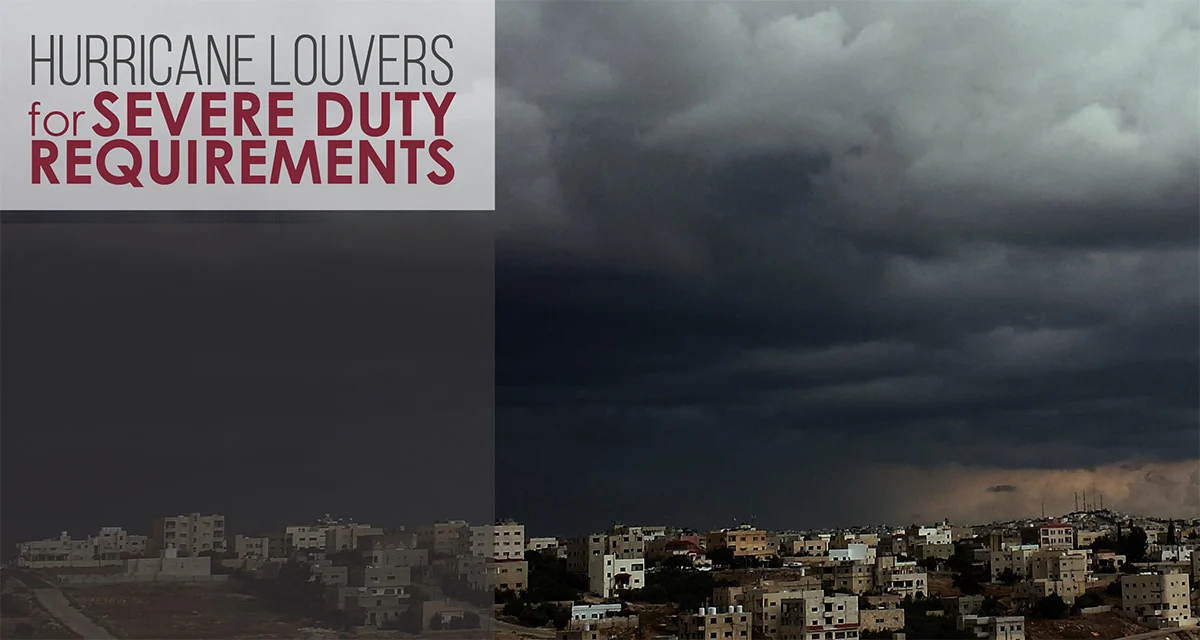Hurricane louvers protect your buildings from the most severe weather events. Louvers must be built, tested, and approved for use as a hurricane louver.
For coastal regions across the US, hurricane season is a dangerous time. People who live in these areas must be prepared for the worst. According to the National Oceanic and Atmospheric Administration (NOAA), the Atlantic hurricane season starts on June 1st and ends on November 30th.
Hurricanes have occurred outside of this period, but it encompasses most of the tropical cyclone activity throughout the year.
Check out these other Newsstand articles for more on louvers:
- The Condenser - Product Spotlight: The EA-531-D Series
- Five Things to Know When Choosing Louvers
- Drainable Louvers for Rainy Days
.webp?width=671&height=346&name=Hubspot%20Blogs%20-%20AMCA%20540%20-%20hurricane%20lineup%20(Resize%202).webp)
Built for Hurricane Season
Hurricane season requires advanced planning. Construction projects in hurricane-prone regions must be prepared for the worst severe weather: winds exceeding 100 miles per hour, flooding rainfall, and the real danger of windborne debris. The material and components used in these projects must adhere to stringent standards for hurricane resilience. All exterior components, including hurricane louvers, must withstand the worst.
Do you have requirements for severe weather louvers? Our friends at Arrow United Industries can help. Contact Arrow United for more on their line of severe weather louvers today.

Hurricane louvers require testing. Manufacturers can test them according to different resilience standards, which fall into two major categories: rejecting high-velocity wind-driven rain and withstanding strikes from windborne debris. To be approved for Miami-Dade County, hurricane louvers need to pass four tests.
- TAS-100(A) determined the louver’s ability to reject rainfall driven by hurricane-force winds.
- TAS-201 determined the louver’s capability to withstand impacts from windborne debris.
- TAS-202 and TAS-203 measured the louver’s ability to withstand the pressure of hurricane-force winds.
Miami-Dade and NOAs
An independent, licensed engineer must review and approve the louver's design. This includes submitting the louver’s drawings, installation details, and relevant calculations for review. Once the louver passes all four tests, and the engineer approves the designs, Miami-Dade County Product Control Section will issue a Notice of Approval, or NOA, which they post online for the public to review.
NOAs expire over time and need to be renewed for the hurricane louver to stay compliant. A louver lacking a current NOA is unusable as a hurricane louver. Miami-Dade County was the original industry authority on hurricane testing and acceptance of hurricane louvers.
.webp?width=532&height=400&name=MCDLG%20Hubspot%20Blog%20-%20Severe%20Weather%20Louvers%20-%20Severe%20Duty%20-%2003amcasite%20(Resize).webp)
Miami-Dade County provides a search tool for finding NOAs on all Miami-Dade approved products, including hurricane louvers.
AMCA Standards 540 and 550
In recent years, building codes have adopted standards from the Air Movement and Control Association (AMCA) for testing hurricane louvers.
- AMCA 540 measures a hurricane louver’s capability to withstand impacts from windborne debris.
- AMCA 540 has two types of listing, based on the test the louver completed: Basic and Enhanced Protection. If the louver passes the testing for enhanced protection, it will receive a matching listing label.
- AMCA 550 measures a hurricane louver’s ability to reject rainfall.
- AMCA 550 has one stage of testing, simulating 8.8 inches/hour of rainfall at four separate wind speeds. The louver must reject at least 99% of all rainfall across all four wind speeds.
There are key differences between these standards and the TAS-100(A) and TAS-201 testing standards. Read “AMCA 540 and AMCA 550: Tougher Standards for Hurricane Louvers” for more on these differences. When a louver has completed and passed these tests, manufacturers can apply an AMCA Listing Label to the product and its submittal document. The listing label will display the tests the louver has passed, much like an AMCA Ratings seal. AMCA will also list the louver online, under their Listed Product Search.
Hurricane louvers require an AMCA Listing Label. Certain hurricane louvers, like Arrow United’s EAV-66, can have an AMCA Listing Label and a Miami-Dade NOA. These louvers underwent testing according to both sets of standards.
In this video, a hurricane louver from MCDLG is subjected to the AMCA 540 missile impact test.
Design for Severe Weather
Hurricane louvers typically use chevron blades to block incoming rainfall. Chevron blades provide excellent protection with minimal effect on the airstream. It is also common for these blades to be mounted vertically in the louver, so that they appear to move from the top of the louver’s face to the bottom instead of side to side. Vertically mounted blades provide similar protection as the traditional horizontal blade, but with easier drainage. Vertical blades can let captured water fall directly to the sill, instead of channeling it into the jambs first.
.webp?width=515&height=500&name=MCDLG%20Hubspot%20Blog%20-%20Severe%20Weather%20Louvers%20-%20Severe%20Duty%20-%20sightline%20(Resize).webp)
The Arrow United EAV-66 uses vertically mounted chevron blades to reject wind driven rain.
Hurricane louvers may also have two sets of blades in the frame, one set horizontal and one set vertical. At MCDLG, we call them Combination Stationary louvers because they contain two sets of stationary blades. Read how they reject rainwater without compromising airflow in our Newsstand article. MCDLG brands offer several combination stationary louvers, including our EA-731-D Series and EA-531-D Series hurricane louvers, both listed for AMCA 540 and AMCA 550. The EA-531-D Series also has an AMCA ratings seal for Wind Driven Rain and Air Performance. You can find out more about these louvers on Product Pro.
- EA-531-D Series: EA-531-D (Arrow United), A531 (Air Balance), AS5D99CS (Airline Louvers)
- EA-731-D Series: EA-731-D (Arrow United), A724 (Air Balance), AS7D99CH (Airline Louvers)
Built to Withstand the Worst
For most louvers, screws will fasten the jambs to the head and sill. Similarly, screws attach each blade to the jamb at a predetermined anchor point. Severe weather louvers use similar fasteners; their design rejects wind-driven rainfall.
Hurricane louver frames must be able to withstand impacts from windborne missiles. Therefore, manufacturers typically weld their frames together. This provides a strong bond between components, so that the louver’s frame remains intact when struck by a windborne missile.
Hurricane louvers will also receive a drain pan as a standard feature. Drain pans provide an avenue for water to drain out of the louver. They also prevent water from splashing back along the louver’s sill and into the ductwork.
.webp?width=671&height=347&name=MCDLG%20Hubspot%20Blog%20-%20Severe%20Weather%20Louvers%20-%20Severe%20Duty%20-%20y%20and%20v%20blade%20(Resize).webp)
Manufacturers build hurricane louvers to withstand the worst weather conditions. They protect the interior from heavy rain, hurricane-force winds, and windborne missiles. These tests and manufacturing methods ensure each hurricane louver is prepared for severe duty scenarios.
Do you have a question on something we haven't covered here? Contact MCDLG by clicking on the button below.
.webp?width=91&height=70&name=MCDLG%20Logo%20(Resize).webp)





